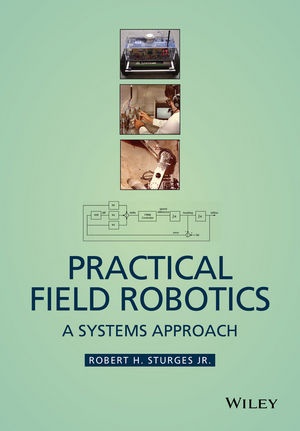Read more
Practical Field Robotics: A Systems Approach is an introductory book in the area of field robotics. It approaches the subject with a systems design methodology, showing the reader every important decision made in the process of planning, designing, making and testing a field robot.
Key features:
* Takes a practical approach to field robotics, presenting the design and implementation of a robot from start to end
* Provides multiple robot examples including those used in in nuclear service, underground coal mining and mowing
* Bridges the gap between existing mathematically based texts and the real work that goes on in research labs all over the world
* Establishes a structured approach to thinking about hardware and software design
* Includes problems and is accompanied by a website providing supporting videos and additional problems
List of contents
Preface ix
1 Overview of Field Robotics 1
1.1 Introduction 1
1.2 Methodology 3
1.3 High-Level Decisions 3
Problems 4
Notes 4
2 A Mobile Robot System for Nuclear Service 7
2.1 Field Environment: Commercial Nuclear Plants 7
2.2 Field Work: Component Maintenance 8
2.3 Equipment Requirements 9
2.4 Conceptual and Operational Designs 12
2.5 Safety and Reliability 19
2.6 Detail Designs of the Service Arm 20
2.7 Detail Designs of the Walker 20
2.8 Conclusion 21
Problems 21
Notes 22
3 The Largest Mobile Robot in the World 23
3.1 Field Environment: Underground Mining 23
3.2 Field Work: Continuous Coal Haulage 25
3.3 Equipment Requirements 26
3.4 Conceptual and Operational Designs 29
3.5 Safety and Reliability 30
3.6 Detail Conceptual Designs 30
3.7 Conclusion 31
Problems 31
Note 31
4 A Mobile Robot for Mowing a Lawn 33
4.1 Field Environment: Suburban Lawns 33
4.2 Field Work: Navigation and Mowing 34
4.3 Equipment Requirements 34
4.4 Conceptual and Operational Designs 35
4.5 Safety and Reliability 37
4.6 Detail Conceptual Designs 37
4.7 High-Level Decisions 37
4.8 Conceptual Design--Technologies 38
4.9 Conceptual Design--Set Parameters 40
4.10 Conceptual Design--Operate Robot 42
Problems 42
Notes 43
5 The Next Levels of Functional Detail 45
5.1 Quantifying Conceptual Design 45
5.2 Quantifying Send Sound 46
5.3 Quantifying Receive Sound 53
5.4 Quantifying Interpret Sound 56
5.5 Design Choices--Setting Parameters 65
5.6 Select a Platform 66
5.7 Select Frequencies 68
5.8 Select Motions 70
Problems 72
Notes 72
6 Operate Robot 73
6.1 Control System 75
6.2 Control System Select Operation 76
6.3 All About main() 78
6.4 Control System--Control Motions 79
6.5 Control Motions--Rotate Motors 81
6.6 Control Motions--Design Infrastructure 83
6.7 Control Motions--Program Speeds 88
6.8 Control Motions--Move Robot 89
6.9 Control Motions--Sequence Motions 92
6.10 Control Information 92
Problems 102
Notes 103
7 Software Functions 105
7.1 Displays: To Place Needed Information to the User Screen 107
7.2 Field Data and Triangulation: Geometric Locating Functions 109
7.3 Operation: The Calls that Make the Robot Move and Stop 121
7.4 History and Diagnostics: The Immediate Past Used for Analysis 130
Problems 136
Note 137
Appendix A: Myth and Creativity in Conceptual Design 139
Appendix B: Real-World Automation Control through the USB Interface 159
Appendix C: Microchip Code for USB Board to PPM Translation 173
Appendix D: Selected Electronic Parts for Mowing Robot 179
Appendix E: Software Concordance 181
Appendix F: Solutions 187
Index 197
About the author
Robert H. Sturges, Jr, Virginia Tech University, USARobert H. Sturges, Jr is a Professor of Industrial and Systems Engineering at Virginia Polytechnic Institute and State University.
He began his career at Charles Stark Draper Laboratories and he spent over ten years at Westinghouse in various product design and manufacturing departments before returning to academia. His 40 years of research experience in industry and academia have included the development and teaching of integrated design-manufacturing methods, and the design and development of advanced automation equipment and robotics.
Summary
Practical Field Robotics: A Systems Approach is an introductory book in the area of field robotics. It approaches the subject with a systems design methodology, showing the reader every important decision made in the process of planning, designing, making and testing a field robot.

